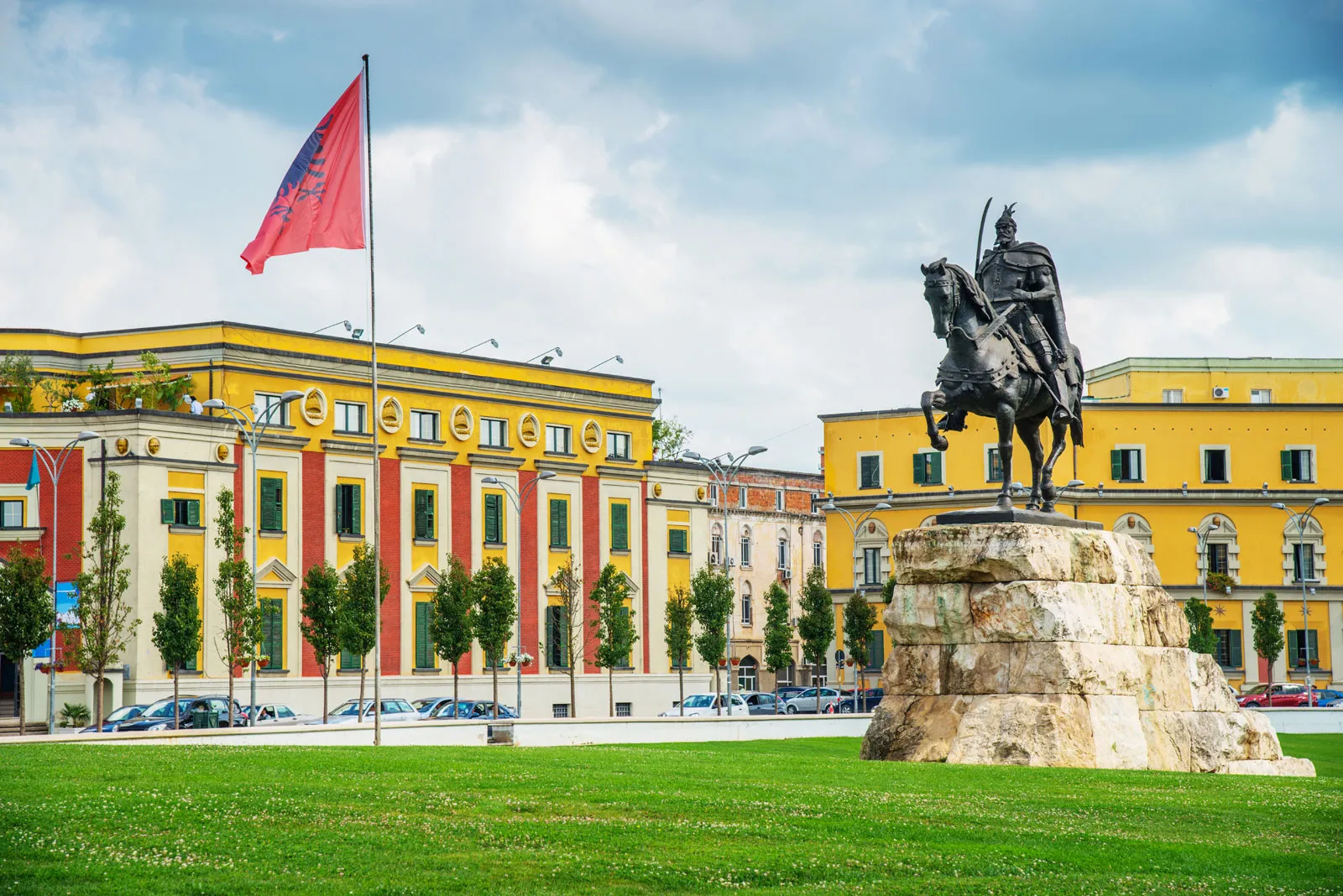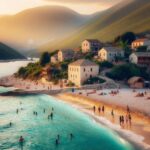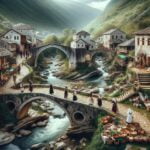Soak up the vibrant atmosphere of Tirana, the thriving capital of Albania. This Balkan gem is a captivating blend of history, culture, and modern flair. Get ready to embark on an unforgettable journey through the city’s narrow streets, uncovering hidden treasures and immersing yourself in its captivating story. Picture a city where ancient roots intertwine seamlessly with youthful energy. It’s a place where the past and present dance together, creating a vibrant melody that will leave you spellbound. Let’s dive into the heart of Tirana and discover the secrets that make this city so captivating.
Capital of Albania: Where the Past Meets the Future
Nestled between the shimmering waters of the Adriatic Sea and the rugged Albanian mountains lies Tirana, the vibrant capital of Albania. This bustling city isn’t just the heart of Albanian politics; it embodies centuries of history colliding with a modern spirit, creating a unique energy that’s palpable from the moment you arrive.
Walking through Tirana is like stepping into a living museum. Ancient Roman ruins whisper stories of emperors and gladiators, while intricate Byzantine mosaics offer glimpses into a world of shimmering gold and devout faith. Tirana’s strategic location at the crossroads of ancient trade routes has woven a rich tapestry of cultural influences. Traditional Albanian customs – like passionate dances and heartfelt hospitality – blend seamlessly with Mediterranean and Ottoman flavors, evident in everything from the delectable cuisine to the city’s architectural marvels.
Today, Tirana thrives as the economic engine of Albania, propelling the nation forward with its entrepreneurial spirit and forward-thinking vision. Shiny new buildings stand tall alongside historical landmarks, a visual testament to Tirana’s commitment to progress. The city buzzes with young professionals and innovative startups, drawn by Tirana’s modern infrastructure and a palpable sense of opportunity.
Yet, even with its eye on the future, Tirana hasn’t forgotten how to celebrate its vibrant culture. Theaters pulse with life, showcasing both traditional Albanian performances and cutting-edge contemporary works. Art galleries burst with color, providing a platform for local artists to share their unique perspectives with the world. As the sun sets, the city comes alive with a vibrant nightlife. Its streets fill with the sounds of laughter, music, and lively conversation spilling out from cozy cafes and trendy bars.
Perhaps one of Tirana’s most endearing qualities is its people. The city is a melting pot of cultures and backgrounds, and Tiranas are known for their warmth, generosity, and infectious zest for life. They welcome visitors with open arms, eager to share their love for their city and its fascinating history. They’ll encourage you to sip strong Albanian coffee at a streetside cafe, savor the rich flavors of byrek (a savory pastry), and lose yourself in the lively atmosphere of a traditional Albanian wedding celebration.
Tirana is a city of contrasts, a place where ancient history whispers in your ear while the energy of a nation on the rise surges through the streets. It’s a city that will surprise you, captivate you, and leave you wanting to discover more of its hidden treasures. Whether you’re drawn to its rich history, its burgeoning art scene, or simply the chance to experience the warmth of its people, Tirana promises a journey unlike any other.
Is Albania in Asia Or Europe?
While Albania’s unique blend of cultures might lead some to wonder about its location, it is firmly situated in Southeastern Europe. Snuggled up against Greece, North Macedonia, Kosovo, and Montenegro, Albania occupies a prime spot on the Balkan Peninsula, with coastlines along both the Mediterranean and Adriatic Seas. This enviable location provides a captivating mix of Balkan and Mediterranean vibes, making it a fascinating destination.
What is the Capital of Albania?
Tirana, a city steeped in centuries of history, stands as not only Albania’s largest city but also its beating heart. With a population exceeding 400,000, Tirana pulsates with life as the country’s administrative, economic, and cultural hub. While its roots run deep, Tirana’s official designation as capital in 1920 marks it as a relatively young capital city.
A journey through Tirana is a captivating blend of old and new. Ancient mosaics whisper tales of the Roman Empire, while the imposing Petrelë Castle stands as a relic of Byzantine times. The legacy of the Ottoman Empire is beautifully preserved in the architecture of the Old Mosque and the türbe, adding another layer to Tirana’s rich tapestry. It’s this fusion of Albanian traditions with Mediterranean and Ottoman influences that give Tirana its unique flavor.
However, Tirana is far from frozen in time. Sleek, modern buildings pierce the skyline, a testament to its growth as a hub for business and commerce. A modern infrastructure ensures smooth transportation, and as the seat of the Albanian government, Tirana plays a pivotal role in national politics and international diplomacy.
Despite its modern advancements, Tirana hasn’t lost its soul. Lush green parks offer a tranquil escape from the urban bustle, charming cafes beckon with the aroma of freshly brewed coffee, and when the sun sets, the city awakens with a vibrant nightlife.
Culture thrives in Tirana. Museums overflow with artifacts and artwork, celebrating Albania’s creative spirit. Theaters come alive with captivating performances, and art galleries showcase a diverse range of styles. As a hub of education, Tirana attracts students from across Albania and beyond, adding to the city’s dynamic energy.
Important Note: Information about cities is constantly evolving. New discoveries, population shifts, and urban development mean that resources like updated travel guides or online encyclopedias can provide the most current information.
Is Tirana Worth Visiting?
Tirana is a city brimming with personality and charm, often overlooked but never disappointing. It’s a place where history whispers from every corner, the culture is lively and engaging, and the people welcome you with open arms.
Tirana thrives on contrasts. Remnants of its Ottoman past sit alongside colorful, Italian-influenced architecture. Bustling markets, filled with the aroma of spices, give way to peaceful parks perfect for relaxation. This eclectic mix is intoxicating.
History buffs will appreciate Tirana’s ability to transport visitors back to the Cold War era. The Museum of Secret Surveillance provides a chilling glimpse into Albania’s communist past, while BunkArt, a museum housed in a massive, formerly secret bunker, offers a deeper understanding of life during that time.
But Tirana is not defined solely by its past. The city pulses with youthful energy, evident in its thriving art scene, trendy cafes, and vibrant nightlife. From traditional Albanian folk music and dance to cutting-edge contemporary art galleries, there’s something for everyone. And the food? Prepare to be amazed. Tirana’s culinary scene is a delicious fusion of Mediterranean flavors with a distinctly Albanian twist.
Getting around Tirana is easy. The city is very walkable, but taxis and buses are also readily available and affordable. The locals are incredibly friendly and always willing to help you find your way.
Tirana’s location makes it an ideal base for exploring more of Albania. The stunning Albanian Riviera is a short trip away, while the majestic Dajti Mountains, accessible by cable car, loom on Tirana’s doorstep.
Tirana will surprise you, captivate you, and leave you wanting more.
What Was the Old Capital of Albania?
Before Tirana became the capital, the honor belonged to Krujë, a captivating medieval city nestled in the rolling hills. In the 12th century, it proudly held the title of Albania’s first independent capital.
Krujë’s place in history is forever intertwined with the legendary Albanian hero, Skanderbeg. As the Ottoman Empire attempted to seize control, Skanderbeg, based in Krujë, led the resistance, transforming the city into a symbol of Albanian strength and the fight for freedom.
However, when Albania declared independence in 1920, a new capital was needed, one that embodied a modern, forward-thinking vision. Tirana, with its central location and ample space for growth, emerged as the perfect candidate, quickly becoming the heart of Albanian politics, economics, and culture.
Today, while Tirana flourishes as a blend of old and new, Krujë remains a captivating destination. Its charming streets and well-preserved medieval architecture serve as a poignant reminder of Albania’s past and the enduring legacy of Skanderbeg.
Is Albania a Rich or Poor Country?
Albania’s economic journey has been remarkable. Once one of the poorest countries in Europe, it has climbed to the “upper-middle-income” category. This significant achievement reflects the country’s progress, but it’s important to note that compared to Western countries, Albania’s average income per person (GDP per capita) remains relatively low.
One of Albania’s successes has been its commitment to reducing the gap between the rich and the poor. Ranking 28th globally in equality demonstrates their efforts to create a more equitable society. However, challenges remain. Poverty persists, and access to essential services like healthcare and education isn’t universal.
Albania’s economic journey is a work in progress, but their commitment to growth and reducing inequality suggests a positive trajectory for the future.
What Language is Spoken in Albania?
The official language of Albania is, unsurprisingly, Albanian. Spoken by nearly 99% of the population, it serves as a unifying force within the country. However, Albanian is nuanced, with two main dialects: Tosk and Gheg. Tosk dominates the south, while Gheg prevails in the north. Official documents and news broadcasts typically use Standard Albanian, based largely on the Tosk dialect.
Due to Albania’s rich history and cultural influences, other languages are also spoken. English, particularly popular among younger generations, is seen as the language of global communication and business. Italian enjoys a strong presence in the south and along the coast due to historical ties. And with Greece being a close neighbor, Greek is the largest minority language spoken in Albania.
Why is Albania Not in the EU?
Despite being an official candidate for EU membership since 2014 and working diligently to meet the EU’s standards, Albania’s accession talks have yet to commence. Several factors have contributed to this delay.
One significant obstacle stems from Bulgaria’s concerns about the rights of ethnic minorities in North Macedonia. The EU often prefers to admit countries in the region in groups, and this impasse has created a roadblock for Albania, despite the country not being accused of discrimination itself.
Internally, Albania has grappled with political instability and challenges related to corruption and organized crime. These issues, taken very seriously by the EU, have necessitated internal reforms and efforts to strengthen governance.
External factors, such as regional tensions in the Balkans and the conflict in Ukraine, have also added layers of complexity to Albania’s EU accession process.
While some experts believe that Albania has made substantial progress and EU accession is inevitable, others are less optimistic given the ongoing challenges and the unpredictable nature of regional and global politics.
Is Albania Still a Communist Country?
Contrary to what some may believe, Albania is no longer a communist country. In 1992, the country transitioned to a democratic government, marking a significant shift in its political landscape. This transition, however, was not without its challenges. The fall of communism led to economic hardship, social unrest, and the rise of the Democratic Party.
The death of Enver Hoxha, Albania’s long-time communist leader, in 1985, is seen as a catalyst for change. His passing opened the door for political and economic reforms, which eventually culminated in the dismantling of the communist system.
Transitioning to a democracy is a process, not an event. Albania continues to navigate the complexities of strengthening its democratic institutions and addressing economic challenges.
Is Albania Recognized by all Countries?
Albania declared independence in 1912, a declaration recognized by many countries, including the United States in 1922. However, it was in 1955 when Albania achieved universal recognition upon becoming a member of the United Nations. This membership solidified Albania’s place in the international community, with recognition from all 193 UN member states.
While UN membership is a significant marker of recognition, Albania’s diplomatic relationships, trade agreements, and cultural exchanges with over 100 countries further underscore its global acceptance as a sovereign nation.
It’s worth noting that international relations can be nuanced. Despite widespread recognition, historical or geopolitical factors may shape how some countries view Albania. These complexities, such as the reasons behind the initial hesitation to recognize Albania’s independence or the global impact of its post-communist reforms, offer insights into the intricacies of international diplomacy.
The story of Albania’s recognition is further enriched by the Albanian diaspora’s role in advocating for their homeland’s place on the world stage. Their efforts highlight the personal dedication and passion behind a nation’s quest for global recognition.
What Rank is Albania in Europe?
Determining Albania’s rank in Europe depends on what we’re measuring. In terms of land area, Albania is the 18th smallest country in Europe, but what it lacks in size, it makes up for in character. Situated in the heart of the Balkans, Albania boasts stunning mountains, beautiful beaches, and a rich history shaped by various empires and cultures.
Key Points to Remember:
- Independence: Albania declared independence from Ottoman rule in 1912.
- Balkan Heritage: Its location in the Balkans has resulted in a vibrant mix of cultures and traditions.
Key Points about Tirana
- Location: Nestled between the Adriatic Sea and the Albanian mountains.
- History: A captivating blend of ancient Roman ruins, Byzantine mosaics, and Ottoman-era architecture.
- Culture: A fusion of Albanian customs with Mediterranean and Ottoman influences, evident in its cuisine, architecture, and way of life.
- Economic Hub: Albania’s economic powerhouse, driving innovation and progress.
- Modern Infrastructure: A mix of historical landmarks and contemporary buildings, supported by a modern infrastructure.
- Vibrant Culture: A thriving arts and culture scene, with theaters, art galleries, and nightlife reflecting both traditional and contemporary influences.
- Welcoming People: Tiranas are known for their warmth, generosity, and enthusiasm, embracing visitors with open arms.
- Melting Pot: A diverse population creates a vibrant mix of cultures and backgrounds.
- Unforgettable Experience: A captivating blend of history, modernity, and cultural immersion that leaves a lasting impression.
Key Points about Albania
- Southeastern European Nation: Located in the Balkan Peninsula, bordered by Greece, North Macedonia, Kosovo, and Montenegro.
- Strategic Mediterranean Location: Coastline along the Adriatic and Ionian Seas, providing access to important trade routes.
- Diverse Geography and Cultural Heritage: Encompasses mountains, plains, and valleys, with a rich cultural heritage influenced by Illyrian, Greek, Roman, Byzantine, and Ottoman civilizations.
- Political Transformation and Independence: Transitioned from a monarchy to a communist regime and ultimately to a democratic republic following its independence in 1912.

















1 thought on “Tirana Unveiled: Exploring the Heart of Albania”
Comments are closed.